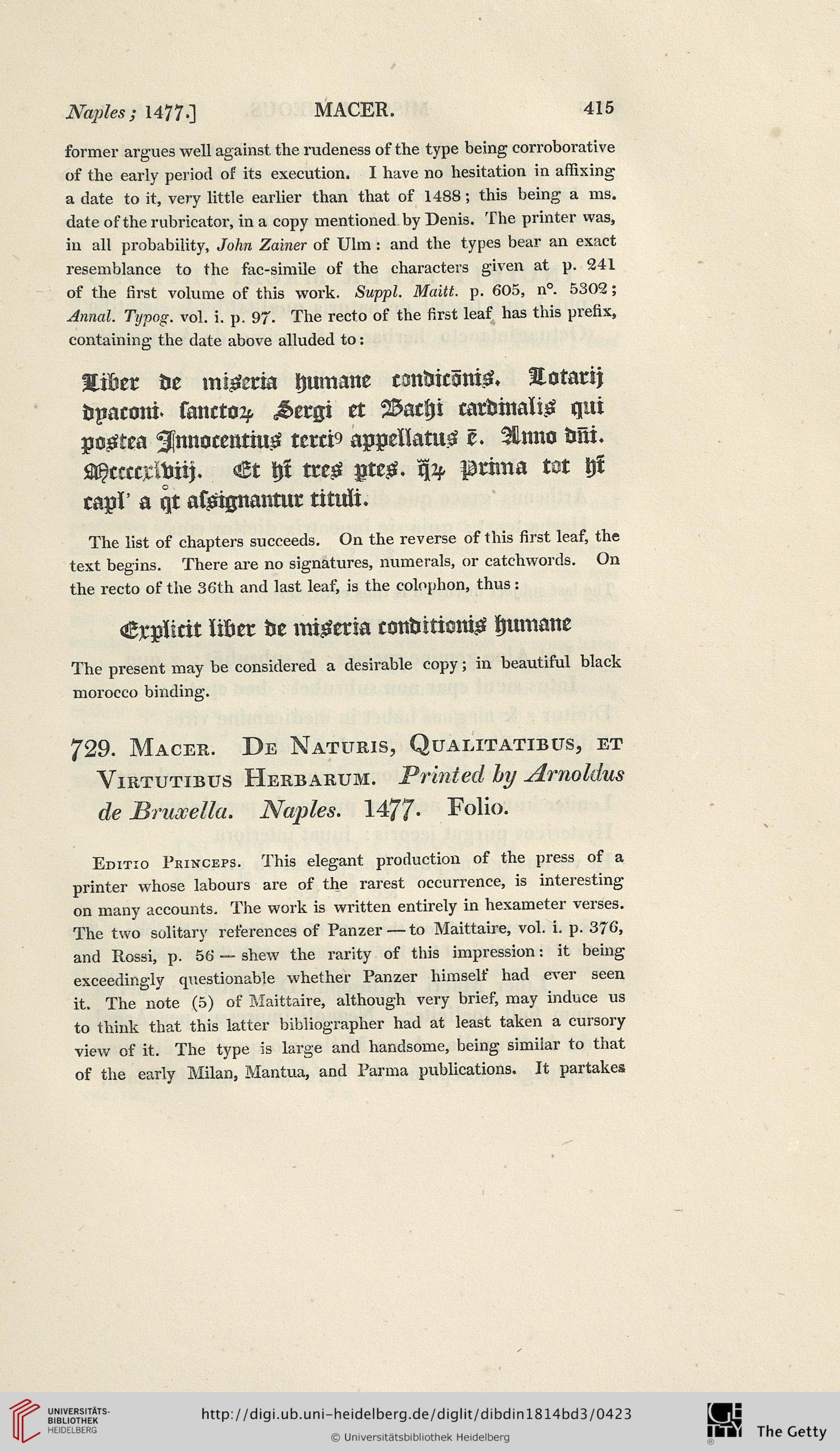MACER.
415
JVaples ; 1477*]
former argues well against the rudeness of the type being eorroborative
of the early period of its execution. I liave no hesitation in assixing
a date to it, very little earlier than that of 1488; this being a ms.
date of the rubricator, in a copy mentioned by Denis. The printer was,
in all probabiiity, John Zainer of Ulm : and tlie types bear an exact
resemblance to the fac-simile of the characters given at p. 241
of the sirst volume of this woi’k. Suppl. Maitt. p. 605, n°. 5302;
Annal. Typog. vol. i. p. 97. The recto os the first leaf has this prefix,
containing the date above alluded to:
XiBer iie Ijumane cmtUiconi^ Eotatij
iipaconi sanctoif ^etgi et 25acfji cartsinali^ qiti
po^tea ^jsnnocentin^ tcrcu appellatuss e. 3Enno Oni.
S^ccccribiij. €t \yt ttc$ gte£. qts prirna tot i)t
capl’ a qt asoigitantur tituii.
The list of chapters succeeds. On the reverse of this first leaf, the
text begins. There are no signatures, numerals, or catchwords. On
the recto of the 36“th and last leaf, is the colophon, thus :
oBjcpMt iifier be migeria contittiom^ ijuntatte
The present may be considered a desirable copy; in beautiful black
morocco binding.
729. Macer. De Naturis, Quaeitatibus, et
Virtutibus Herbarum. Printecl hy Arnoldus
de JBvuwella. Naples. 1477- Folio.
Editio Princeps. This elegant production of the press of a
printer whose labours are of the rarest oceurrence, is interesting
on many accounts. The work is written entirely in hexameter verses.
The two solitary references of Panzer—to Maittaire, vol. i. p. 376,
and Rossi, p. 56 — shew the rarity of this impression: it being
exceedingly questionable whether Panzer liimself had ever seen
it. The note (5) of Maittaire, although very brief, may induce us
to think tliat this latter bibliographer had at least. taken a cursory
view of it. The type is large and handsome, being simiiar to that
of tlie early Milan, Mantua, and Parma publications. It partakes
415
JVaples ; 1477*]
former argues well against the rudeness of the type being eorroborative
of the early period of its execution. I liave no hesitation in assixing
a date to it, very little earlier than that of 1488; this being a ms.
date of the rubricator, in a copy mentioned by Denis. The printer was,
in all probabiiity, John Zainer of Ulm : and tlie types bear an exact
resemblance to the fac-simile of the characters given at p. 241
of the sirst volume of this woi’k. Suppl. Maitt. p. 605, n°. 5302;
Annal. Typog. vol. i. p. 97. The recto os the first leaf has this prefix,
containing the date above alluded to:
XiBer iie Ijumane cmtUiconi^ Eotatij
iipaconi sanctoif ^etgi et 25acfji cartsinali^ qiti
po^tea ^jsnnocentin^ tcrcu appellatuss e. 3Enno Oni.
S^ccccribiij. €t \yt ttc$ gte£. qts prirna tot i)t
capl’ a qt asoigitantur tituii.
The list of chapters succeeds. On the reverse of this first leaf, the
text begins. There are no signatures, numerals, or catchwords. On
the recto of the 36“th and last leaf, is the colophon, thus :
oBjcpMt iifier be migeria contittiom^ ijuntatte
The present may be considered a desirable copy; in beautiful black
morocco binding.
729. Macer. De Naturis, Quaeitatibus, et
Virtutibus Herbarum. Printecl hy Arnoldus
de JBvuwella. Naples. 1477- Folio.
Editio Princeps. This elegant production of the press of a
printer whose labours are of the rarest oceurrence, is interesting
on many accounts. The work is written entirely in hexameter verses.
The two solitary references of Panzer—to Maittaire, vol. i. p. 376,
and Rossi, p. 56 — shew the rarity of this impression: it being
exceedingly questionable whether Panzer liimself had ever seen
it. The note (5) of Maittaire, although very brief, may induce us
to think tliat this latter bibliographer had at least. taken a cursory
view of it. The type is large and handsome, being simiiar to that
of tlie early Milan, Mantua, and Parma publications. It partakes




